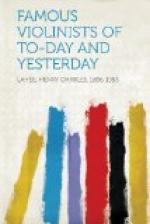He lived on terms of intimacy with the leading artists of his time, and had a great fondness for pictures, of which he had a valuable collection. These he left at his death to Cardinal Ottoboni.
It was at Cardinal Ottoboni’s that Corelli became acquainted with Handel, and at one of the musical evenings there a “Serenata,” written by the latter, was performed. Corelli does not seem to have played it according to the ideas of the composer, for Handel, giving way to his impetuous temper, snatched the fiddle out of Correlli’s hand. Corelli mildly remarked, “My dear Saxon, this music is in the French style, with which I am not acquainted.”
For many years Corelli remained at Rome, but at last he yielded to temptation and went to Naples, where Scarlatti induced him to play some of his concertos before the king. This he did in great fear, for he had not his own orchestra with him. He found Scarlatti’s musicians able to play at first sight as well as his own did after rehearsals, and, the performance going off well, he was again admitted to play, this time one of his sonatas, in the royal presence. The king found the adagio so long and dry that he quitted the room, much to Corelli’s mortification. But greater trouble was in store for the virtuoso. Scarlatti had written a masque, which was to be played before the king, but owing to the composer’s limited knowledge of the violin, Corelli’s part was very awkward and difficult, and he failed to execute it, while the Neapolitan violinists played it with ease. To make matters worse, Corelli made an unfortunate mistake in the next piece, which was written in the key of C minor, and led off in C major. The mistake was repeated, and Scarlatti had to call out to him to set him right. His mortification was so great that he quietly left Naples and returned to Rome. He found here a new violinist, Valentini, who had won the admiration of the people, and he took it so much to heart that his health failed, and he died in January, 1713.
Corelli was buried in princely style in the Pantheon, not far from Raphael’s tomb, and Cardinal Ottoboni erected a monument over his grave. During many years after his death a solemn service, consisting of selections from his own works, was performed in the Pantheon on the anniversary of his funeral. On this occasion, the works were performed in a slow, firm, and distinct manner, just as they were written, without changing the passages in the way of embellishment, and this is probably the way in which he himself played them.
Corelli’s compositions are remarkable for delicate taste and pleasing melodies and harmonies. He must be considered as the author of the greatest improvement which violin music underwent at the beginning of the eighteenth century. These compositions are regarded as invaluable for the instruction of young players, and some of them may be frequently heard in the concert-room at the present day, two hundred years since they were written. Corelli’s most celebrated pupils, Somis, Locatelli, Geminiani, and Anet, settled respectively in Italy, Holland, England, and Poland.




